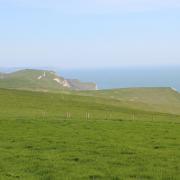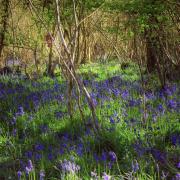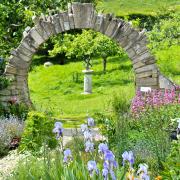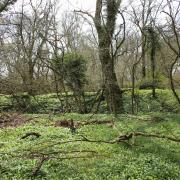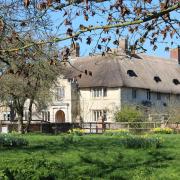From spotting red squirrels on Brownsea to fragrant carpets of bluebells in ancient woodland, immerse yourself in the sights, scents and sounds of a Dorset spring

Spring Stroll at Langdon Hill Woods
from Sue Dampney, Dorset AONB Team
This is a favourite walk at any time of year, but the fresh lime-green of the beech trees bursting into life in spring makes it extra special. Langdon Hill woods sits on the shoulder of land rising between Chideock and Morcombelake, near Bridport. Owned by the National Trust, it’s popular with walkers heading out for a stomp up nearby Golden Cap. However, Langdon Hill offers a delightful walk in itself – the hill is clothed in beech and Scots pine woodland, and bluebells abound here.
From the car park, a wide, even track takes you clockwise around the hill, overhung with beech trees and offering glimpses to the Jurassic Coast. As the track rises, the tree cover changes to the mature Scots pines planted here during the world wars for timber, it’s the perfect place for children to build their secret dens.
The track veers west and north, offering stunning views across to Golden Cap and Stonebarrow between the beech trees slender trucks. There are glorious bluebells in late April and early May on these western slopes, take the lower path at the bottom of the trees to fully immerse yourself in them! But for now, stick to the track which takes you full circle back to the car park. Nearby Felicity’s Farm Shop has a great selection of local food and hot drinks after your walk.
Details: Take A35 west from Chideock, take the secluded turn left near top of hill, just before Felicity’s Farm Shop at Morcombelake. Follow National Trust signs to turn left again, car park ¼ mile along track (DT6 6EP; Grid Ref: SY412930). X51/53 stops at Star Lane and The Bakery in Morcomblake nearby. Access Langdon Hill from the South West Coast Path too. Distance: 1.4miles/2.25km.
nationaltrust.org.uk/visit/dorset/golden-cap/langdon-hill-walk

A Ramble at Turnworth Down
from Ian Rees, Dorset AONB Team
Tucked away in the headwaters of the North Winterbourne Valley, near Winterbourne Stickland, is a magical little place well worth exploring: Ringmoor and Turnworth Down. And it really is exploration, as there’s no need to stick to the footpaths through this National Trust countryside site. Open access means you have the freedom to seek out the best bits.
Turnworth Down is a great example of wood pasture, a habitat that is the best of both grassland and woodland, meaning it’s a wildlife hotspot. So, at different times of year, you’ll find verdant wildflowers, including orchids, an array of grassland and woodland fungi, craggy and ancient trees, and – heralding in the spring – a carpet of bluebells that lift the soul. This is a great place to look out for ancient trees, remnants from the lapsed wood pasture management such as huge, pollarded ash and holly and impressive ancient ash coppice stools.
The site is managed by Wessex Conservation Grazing, a successful business that manages the land for both nature and for food. Aberdeen Angus cattle graze the site all year, with new-born calves present from March (so it’s very important to keep dogs on leads and away from the cattle at this point).
The site is also steeped in history. There is evidence everywhere you look of how our ancestors lived, including the prehistoric field system associated with the settlement of Ringmoor.
Details: Park in the layby just off the valley road between Winterbourne Stickland and Okeford Fitzpaine. Grid Ref: ST 81610849. More parking nearby, at Okeford Hill Picnic Site, with access along the Wessex Ridgeway. Grid Ref: ST 81220937.
dorsetaonb.org.uk/location/ringmoorandturnworth/

Walk or Cycle the Woodland Trail at Kingston Lacy
from Clare Gascoigne of the National Trust
With a succession of woodland plants to admire from snowdrops through to bluebells and wild garlic, and frolicking Portland lambs, usually near the house where the rangers can keep an eye on them, this really is the perfect springtime family walk. Explore this easy circular route on foot or by bike. From the car park, head into the grounds via the Visitor Centre and turn right. Keep left, passing through a large white gate. Take small black gate to your right, head along this path following green signs. Once you reach a wooden gate on your left, pass through it, continue on this track across the field and into the woodland. Turn right and follow the trail as it winds its way west and then north through the native deciduous woodland, look out for daffodils, bluebells and wild garlic. Pass the woodland play area and continue towards Blandford Lodge by the main road. Follow the path as it passes Blandford Lodge and bends around to the right onto a tarmac road. Cross the entrance drive at the marked crossing point, then turn left to follow the track along the side of the drive and through a black gate on the right into more woodland. Continue through the woodland and along the boardwalk to the end, go through the gate and follow the trail in front of you. At track junction turn right and continue. Turn right at this track junction and follow the tarmac path back up towards Kingston Lacy house and the car park.
Details: Starts from Kingston Lacy car park, BH21 4EA. Grid ref: ST977014. Distance: 2.9 miles/4.64km. Time: 2 hours 20 mins. Smooth gravel tracks, suitable for wheelchairs. Dogs on leads. Normal admission applies, NT members free, see website for details.
nationaltrust.org.uk/visit/dorset/kingston-lacy/the-woodland-trail-at-kingston-lacy

Squirrel Spotting on Brownsea Island
from the National Trust’s Brownsea Island Team {300} {pics}
Spring is a great time to observe Brownsea’s resident red squirrels in action and you’re sure to see them on the Woodland Walk. Starting next to the island’s church, catch a glimpse of the internationally important Brownsea Lagoon through the trees and listen to the sounds of waders, wildfowl and other birds. Having taken advantage of the sheltered sanctuary that the lagoon offers birds in Poole Harbour, these winter visitors are starting to return to their northern summer homes. New spring arrivals include the common and Sandwich tern and, later, the nightjar, which spend the summer nesting and raising their young on the island.
From the Woodland Walk, continue to the island’s natural play area following one of the main tracks up Middle Street. Or take a left to the Lily Pond where you may catch early dragonflies and damselflies on the wing as the weather warms up. From here follow the track to Daffodil Field, where – as the name suggests – in spring you can admire a display of daffodils unless Poole Harbour’s island-hopping deer haven’t got to them first! At the turn of the last century, daffodils and narcissi were grown commercially on Brownsea for both blooms and bulbs. From Daffodil Field, either loop back to the Visitor Centre for a shorter walk or continue along the main track to the Outdoor Centre and Scout Stone, then onto Penelope Park, and Maryland for a complete loop of the island, taking in heathland and woodland habitats as you go.
Details: The Woodland Walk, which is waymarked, takes about an hour (pick up maps from Visitor Reception). To extended walk is an additional 45 minutes. Tracked paths are suitable for all-terrain wheelchairs and pushchairs (available to pre-book). Access to Brownsea is via ferry from Poole Quay or Sandbanks. nationaltrust.org.uk/visit/dorset/brownsea-island

Orchids and Butterflies at Catswhisker Wood & Ashley Wood
from Hazel Ormrod of Dorset Wildlife Trust
A stroll through one of Dorset's wild woodlands in the spring sunshine must be one of the most rewarding moments of the year. Pause to take in the natural world, from breathing in the fragrant bluebells to listening to birdsong and the buzz of insects.
The first walk is within the Cranborne Chase Area of Outstanding Natural Beauty (AONB). Fontmell Down nature reserve, near Shaftesbury, is a stunning location owned and managed by Dorset Wildlife Trust. Spring is a great time to visit and there is a 1 ½ mile circular walk which takes you through Catswhisker Wood where the dense undergrowth, provides a home for the elusive hazel dormouse. At the far end of the wood is the entrance to Littledown where in springtime, you will find a carpet of yellow cowslips as well as far-reaching views across to the slopes of Big Bury and Little Bury.
There are ten species of orchid at Fontmell Down. These can be found in the ancient woodlands and on the chalk downland. Look out for the early purple orchid with its distinctive magenta flowers and long dark spotted leaves. For this walk park in the National Trust car park at Spread Eagle Hill where charges may apply.
Another wonderful woodland reserve to visit in spring is Ashley Wood near Tarrant Keyneston. Imagine standing in a Dorset wood, ancient ash, and hazel trees surround you; at your feet there is a carpet of wood anemones and bluebells. The songs of woodland birds fill the air and butterflies such as speckled wood, white admiral and silver-washed fritillary flutter by. Ashley Wood truly is a magical place to immerse yourself on a sunny Dorset spring day.
Details: Head to dorsetwildlifetrust.org.uk/nature-reserves for more details about parking and walking trails for both these locations and others in Dorset.

Drinking in the View on the Shipstal Trail at RSPB Arne
from Lesley Gorman of the RSPB
I discovered this walk many years ago when I regularly visited Dorset for camping trips from London. RSPB Arne was, and still is, one of my favourite places. The timeless presence of woodland filled with birdsong in spring soothes away any day-to-day stresses
The Shipstal Trail is a circular walk of about 2.5 miles (with options for shorter routes), which takes you through ancient oak woodland, farmland and heathland. It can also include a shoreline stroll by mudflats much favoured by wading birds such as spoonbills. The walk begins at the RSPB Arne nature reserve entrance and starts with a small incline. The remainder of the walk is either flat or gently undulating, so suitable for children or buggies. There is an accessible parking area within the reserve (blue badge holders ask at Welcome Area for permit). Mobility scooters can be hired in advance, book at bit.ly/HireTramper.
Bring a picnic or buy sandwiches from the onsite café which offers locally sourced, organic produce, plant-based options and home baked goodies. Find a bench or a log to sit and absorb the sights and sounds of spring. My favourite viewpoint is at the very start of the trail where you can gaze across the heathland to Poole Harbour in the east or the Purbeck Hills and Corfe Castle to the west. There is no better place to spend a spring day, immersed in the glorious symphony of birdsong and feasting your eyes on those Dorset views.
Details: Circular route around 2 miles, allow 1 ¾ hours to complete the trail. The route takes you through a wide variety of habitats at RSPB Arne and includes Shipstal viewing screen overlooking the saltmarsh. The criss-cross of trails includes two shorter walks hour long walks (yellow and green trail).
rspb.org.uk/globalassets/downloads/documents/reserves/arne-trail-guide.pdf

Woodlanders at Duncliffe Wood
from the Woodland Trust
The spectacular north Dorset spring is displayed to glorious effect in both sight, sound and fragrance at Duncliffe, one of the region’s oldest and largest woods. This magnificent ancient woodland perches on the twin summits of Duncliffe Hill and can be seen from miles around.
Duncliffe Wood, which was bought by the Woodland Trust in 1984, is renowned for its rich Iron Age history and Domesday Book mention, as well as inspiring Thomas Hardy’s 1887 novel The Woodlanders. But here at the Woodland Trust, we love it just as much for its enchanting wildflowers as its archaeological features. Historical artefacts discovered in the wood include two bronze statuettes which are thought to link the site to ancient fertility rituals. One, found on Duncliffe Hill, was an Iron Age bronze statuette of a boar.
A thriving Site of Nature Conservation Interest, look out for 20 different butterflies and carpets of bluebells on your spring stroll. Wildlife such as the tawny owl and six species of bat make their home here too. Explore a mix of open glades, paths and trees, including the old coppice stools of small-leaved limes on a variety of routes. The Oak Route is the longest, or choose the Butterfly Route through fields of wildflowers with flitting butterflies, the shady Bluebell Route, or a quiet stroll past nesting boxes on the Owl Route. The Hardy Way, a long-distance route, runs through the wood. Information boards at the three main entrances highlight four walking routes.
Details: Duncliffe Wood is at Stour Row, 3 miles west of Shaftesbury. The main access is via a track from the car park off New Lane, into the western side of the wood. Other access points are along public rights of way from the south, north and east via kissing gates and bridleway gates.
woodlandtrust.org.uk/visiting-woods/woods/duncliffe-wood/

Bluebells at Shire Rack, Garston Wood and Mistleberry Wood
from Cranborne Chase AONB
This is one of the Chase & Chalke walks from the Ancient Ways projects which includes drove-ways high on the ridges to the south of the A30, sunken hollow-ways, old Roman Roads and the Shire Rack. These were the main routes between settlements before the motorcar.
The Shire Rack, running west from RSPB Garston Wood car park, is a public footpath which follows an early routeway along the chalk ridge between the two counties. ‘Shire’ from the Old English word for a county, and ‘rack’ meaning ‘reach’ or ‘a narrow path’. The Shire Rack is ‘registered’ in Anglo-Saxon charters for the manors of Chalke to the north and (Sixpenny) Handley to the south, with a list of boundary features along its course in AD 955/6; so, you are following in the footsteps of those 10th-century land surveyors. There is evidence of centuries of boundary management of this ‘linear woodland’, with large veteran tree stools and rows of formerly coppiced hazels. Julius Caesar noted the defensive potential of rows of coppiced hazels creating ‘wall-like hedges’ which impeded the Roman cavalry.
Garston Wood, once a pulling-in area for livestock, mules and horse-drawn wagons, is now an RSPB nature reserve. This ancient woodland is at its best in spring with breathtaking carpets of bluebells, wood anemones and primroses (mid-April to end of May), and birdsong from blackcaps, willow warblers and garden warblers. The route also takes in Mistleberry Wood with its unfinished Iron Age hillfort, which is shrouded in mystery.
Details: Start Point: RSPB Garston Wood car park. W3W: clumped.orchids.plays | Grid Ref: SU 003 195. Terrain: Woodland paths, field margins and grassy paths, gravel tracks and country lanes. Distance: 3.1 miles/5 km. Time: 1.5 hours. Dogs: On leads in RSPB reserve.
cranbornechase.org.uk/wp-content/uploads/2022/11/W23-Shire-Rack-WEB.pdf

Violets at Sixpenny Handley, Chase Woods and Woodcutts
from Cranborne Chase AONB
Explore the historic village of Sixpenny Handley, the British Romano settlement at Woodcutts and the Shire Rack, an ancient county boundary between Dorset and Wiltshire on this circular walk, which also takes in Chase Wood.
Originally known as ‘Handley, or ‘Handley St Mary’, Sixpenny Handley’s name is derived from two medieval hundreds ‘Sexpena’ (Saxon hilltop) and ‘Hanlega’ (high clearing), which by the 14th century were united as the hundred of ‘Sexpenne et Henle’. The notorious Dorset smuggler Isaac Gulliver married innkeeper William Beale’s daughter Betty at Sixpenny Handley church on 5 October 1768. It’s unlikely that he used the village for his dubious enterprise as it is around 30 miles inland. However, Gulliver had a local sideline of poaching deer on Cranborne Chase, a tomb adjoining the local church is reputedly where ‘hot’ venison could be stored!
In Chase Wood you will see evidence of coppiced hazel, the practice of cutting trees and shrubs to ground level, promoting vigorous re-growth and a sustainable supply of timber for hurdles, stays for thatching and charcoal. Coppicing lets more light and heat reach the woodland floor allowing bluebells, wood anemone and dog violets to thrive, which in turn provides nectar for butterflies and other pollinators in March, April and May. This route takes you through Barber’s Coppice, Great Shaftesbury Coppice, Withywind Coppice, Brockwell Coppice and Greatstone Coppice, where you can admire wonderful displays of delicate spring flowers.
Download the free Cranborne Chase Time Traveller App to find out more about Gulliver and Woodcutts British Romano settlement.
Details: Start Point: Handley Crossroads, Grid Ref: SU 0000 1705, W3W: drilling.strongman.chainsaw. Park considerately in the village. Terrain: Roads, lanes, woodland and field tracks and bridleways. Distance: 7.4 miles /11.9 km. Time: 3.5 hours Dogs: On leads - livestock, ground nesting birds, roads and golf course.
cranbornechase.org.uk/wp-content/uploads/2022/05/W22-Sixpenny-and-Woodcuts.pdf




